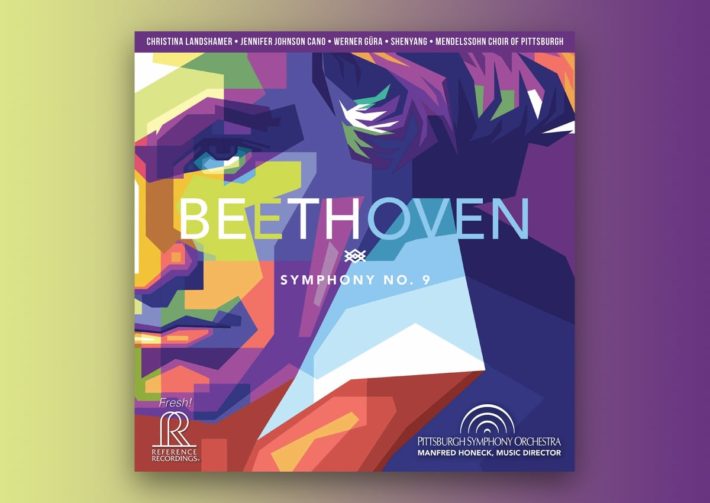Honeck and his Pittsburgh orchestra has previously released recordings of Beethoven’s third, fifth and seventh symphonies, performances that have received almost universal acclaim, so any listener rightfully comes to this new release with the highest expectations. In those recordings Honeck successfully blends historically informed ideas with an ‘old school,’ Romantic approach, an interpretative stance which seem particularly suited to the ninth symphony. So, it is surprising to hear a reading that is more overtly influenced by historically informed performance practice: divided violins, timpani played with hard sticks, and winds, especially brass, forwardly balanced. More surprisingly, Honeck honors most of Beethoven’s metronome markings, in a performance of 62 minutes. This puts his reading in the same category as two other historically informed performances played by modern orchestras: the Philharmonia Orchestra conducted by Mackerras (Hyperion) and de Vriend leading the Netherlands Symphony Orchestra (Challenge Classics).

See offers for this album on Amazon.
While Mackerras and de Vriend encourage a leaner, agile sound, Pittsburgh has an opulent weight that, in a closely miked recording, can feel overbearing. This is not a critique of Pittsburgh’s playing, which is above reproach. Every technical challenge is easily met, and the playing has tremendous energy and clarity. But the recorded sound does at times feel constrained, like climaxes cannot fully bloom.
Honeck, who has a propensity for adding articulation and dynamic marks, does so throughout the symphony – his first change comes as early as 1:24 in the first movement. At 7’45” there is a particularly jarring example as the brass make drastic subito-pianos to ensure the string’s motive is clearly heard. This is not a new idea – most conductors do something similar, but Honeck’s way is so pronounced that it removes any sense of the strings striving to be heard over those brass chords. But that struggle to be heard is the point of this angst-ridden climax, and Honeck’s meddling robs the climax of its emotional power. His extensive liner notes spend a considerable of effort rationalizing his many changes. Yet, after repeated listening, many of his alternations sound unconvincing and mannered.
The second movement is excellent, its complex contrapuntal textures portrayed with precise articulation and great clarity. Honeck’s tempo for the trio, while not as fast as Beethoven’s metronome marking, is faster than most, and very effective, the bassoon (6’50”) playing particularly impressive. The Reference engineers ensure we hear plenty of wind writing, though the brass is often overly prominent in the balance. We hear not only their important melodic motives, but any part marked above forte. Beethoven often uses the brass to add sonority or rhythmic impetus, or subtly change orchestral coloration. Here (and throughout the symphony), the brass is so ubiquitous that it often distracts from more important melodies and motifs in the other instruments.
Related Classical Music Reviews
- Review: Beethoven – Symphony No. 9 – Masaaki Suzuki
- Review: Tchaikovsky – Symphony No. 4, Leshnoff – Double concerto – Honeck
- Review: Beethoven – Complete Symphonies – Vienna Philharmonic Orchestra – Nelsons
- Review: Beethoven – Symphonies No. 5 and 7 – NDR, Manze
Anyone who first heard the Adagio in readings by Karajan, Haitink or Solti may find Honeck’s 12’34” performance too fast, though Beethoven’s metronome marking does ask for these speeds. The Pittsburghers play with breathtaking beauty; as each variation grows in complexity, everything line is carefully shaped and clarified. But brass fanfares at 9’03” have little emotional impact, or sense of arrival. Despite the magnificent sound of the orchestra, the emotional complexities of the music go mostly unexplored. The recent Bach Collegium Japan recording, which takes roughly two minutes longer than here, taps the spiritual depths of this music with far more success.
In his introductory notes, Honeck described developing a text for the cello/bass recitative in the opening minutes of the final movement. This text is what provides the shape and articulation for the passage. Why this was required is unclear. Beethoven asks that the passage to be played “like recitative, but in tempo” and over 40 years of historically informed conductors have revealed how powerfully this passage speaks simply doing what Beethoven asks! If the added text is intended to add deeper rhetorical power, it has just the opposite effect.
Choir and soloists sing with evident passion and clear diction, though the soprano section develops a pronounced vibrato when singing forte above the staff. Frustratingly, the choral parts are rife with questionable articulation and shaping intervention: at 7’46” the soloists sing their phrases with beautiful legato, but the choir responds with clipped, brittle articulation. The march is sung with unbridled enthusiasm by the tenor and men of the choir, leading into the first fugue, played with unnerving virtuosity at a startlingly fast tempo. But when the choir enters (12’09”), they are asked to accent every sing syllable (this not what is asked for in the score). I am sure the intent is overwhelming joy, but it feels being ordered to be joyful. In the slow section that follows, the choir softens the last syllable of several words. Encouraging a choir to sing text with the same stresses it has when spoken is not a new idea, but here it is overdone and calls attention to the articulation rather than the meaning of the words. Thankfully the final sections (from 18’26”) goes splendidly.
This performance rarely met my expectations, both in terms of interpretation and recorded sound. The Pittsburgh Orchestra is impressive throughout, following every of Honeck’s interpretive ideas with complete conviction. But if the reader is searching for a recording by a modern orchestra playing in an historically informed style, Mackerras and de Vriend remain the primary recommendations.

Beethoven – Symphony No. 9, Op. 125
Christina Landshamer – Soprano
Jennifer Johnson Cano – Mezzo Soprano
Werner Güra – Tenor
Shenyang – Bass-Baritone
Mendelssohn Choir of Pittsburgh
Pittsburgh Symphony Orchestra
Fresh!/Reference Recordings, CD FR-741SACD

See offers for this album on Amazon.

















